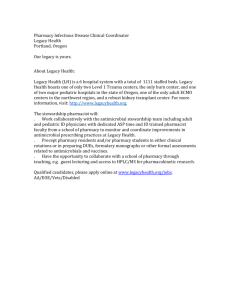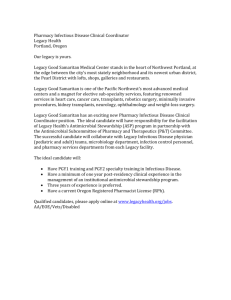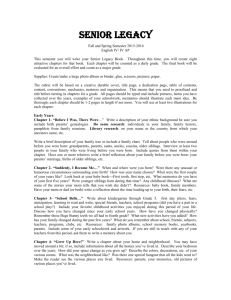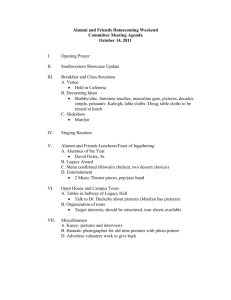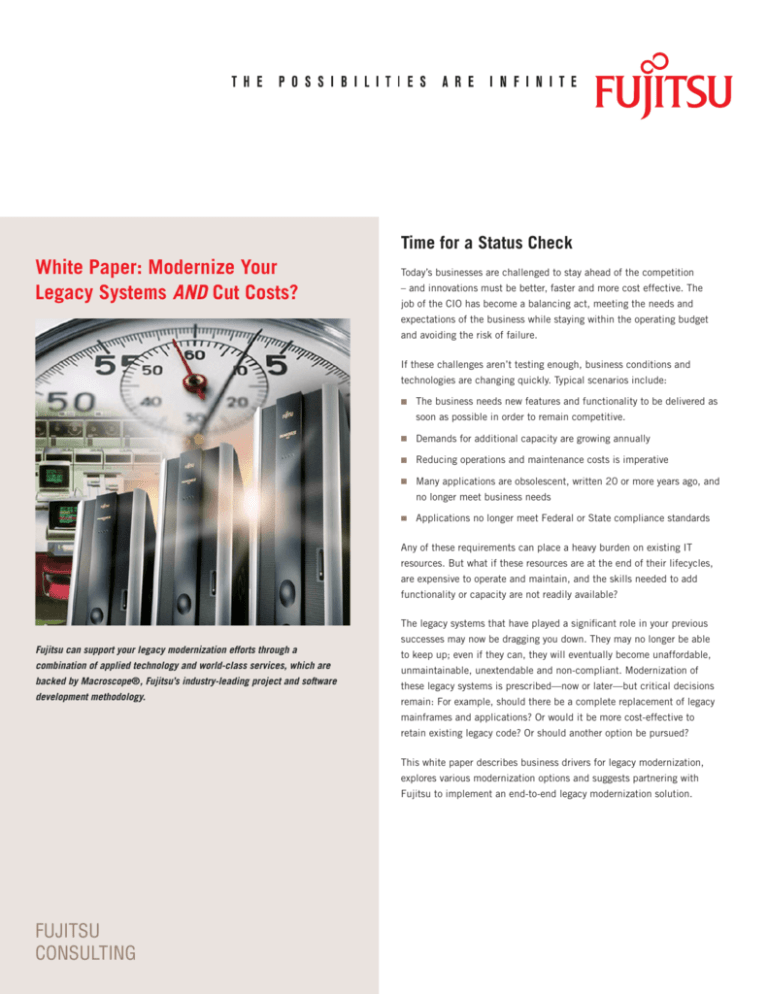
Time for a Status Check
White Paper: Modernize Your
Legacy Systems AND Cut Costs?
Today’s businesses are challenged to stay ahead of the competition
– and innovations must be better, faster and more cost effective. The
job of the CIO has become a balancing act, meeting the needs and
expectations of the business while staying within the operating budget
and avoiding the risk of failure.
If these challenges aren’t testing enough, business conditions and
technologies are changing quickly. Typical scenarios include:
The business needs new features and functionality to be delivered as
soon as possible in order to remain competitive.
Demands for additional capacity are growing annually
Reducing operations and maintenance costs is imperative
Many applications are obsolescent, written 20 or more years ago, and
no longer meet business needs
Applications no longer meet Federal or State compliance standards
Any of these requirements can place a heavy burden on existing IT
resources. But what if these resources are at the end of their lifecycles,
are expensive to operate and maintain, and the skills needed to add
functionality or capacity are not readily available?
The legacy systems that have played a significant role in your previous
Fujitsu can support your legacy modernization efforts through a
combination of applied technology and world-class services, which are
backed by Macroscope®, Fujitsu’s industry-leading project and software
development methodology.
successes may now be dragging you down. They may no longer be able
to keep up; even if they can, they will eventually become unaffordable,
unmaintainable, unextendable and non-compliant. Modernization of
these legacy systems is prescribed—now or later—but critical decisions
remain: For example, should there be a complete replacement of legacy
mainframes and applications? Or would it be more cost-effective to
retain existing legacy code? Or should another option be pursued?
This white paper describes business drivers for legacy modernization,
explores various modernization options and suggests partnering with
Fujitsu to implement an end-to-end legacy modernization solution.
FUJITSU
CONSULTING
Why Modernize?
There are compelling reasons for legacy modernization, notably cost, competition, regulatory compliance and
consolidation.
Business Driver 1: Cost
Driving the need for change is the high—sometimes staggering—cost of operating and maintaining legacy
systems. These costs typically eat up a large percentage of the IT budget, diverting funds that could otherwise
be used for new projects.
Adding to the cost is the expense of maintaining code. The original designers, programmers and users have long since
left the organization; levels of specialized skills and knowledge have decreased as the systems themselves have aged.
Lack of planning inevitably means that there is redundancy in systems, applications, data and reporting.
It can be very expensive to maintain these systems while keeping their functionality intact.
Business Driver 2: Competition
Agility is essential in a competitive world. Your IT systems must be able to respond rapidly to changing
requirements by supporting new features and functionality.
However, legacy applications are notoriously difficult to scale or adapt; as a result, your systems may lack the
capacity or computing power to accommodate your business needs.
Business Driver 3: Regulatory Compliance
Regulatory compliance – imposed by Sarbanes-Oxley (SOX), Health Insurance Portability and Accounting Act (HIPAA),
Securities and Exchange Commission (SEC) 17a4, Gramm-Leach-Bliley and others – may force the introduction of
new IT capabilities, such as control point automation or records management. Just one lawsuit requiring a cycle of
electronic discovery can justify the implementation of an enhanced content management system.
Business Driver 4: Consolidation
In recent years, large numbers of mergers, acquisitions and reorganizations have combined to create complex
IT infrastructures consisting of loose configurations of disparate hardware and software. New initiatives (such as
ERP, CRM and ECM) mean functionality and capacity must be added to or subtracted from this aging hodgepodge. The high costs involved in integrating or consolidating these diverse systems often triggers a legacy
modernization initiative.
Why Not modernize?
The day you put a new system into production, it becomes a legacy system—that is a reality of business. And,
unless you dispose of it, one day you will face the challenge of modernizing this system to meet new business or
technology needs.
However, this effort can deliver a broad range of benefits, such as:
Reducing management and support costs by standardizing IT platforms
Embracing change by better aligning IT and your business processes
Enhancing and leveraging processes and technologies enterprise-wide
Taking advantage of the capabilities and functionality delivered by new technologies
What are my options?
Many organizations are looking for low-risk opportunities to extend and transform legacy systems; others are
maintaining the status quo – often a conscious decision. Other legacy modernization options include re-hosting,
re-engineering, consolidation and replacement, each of which is explored in this paper.
Cost reduction and avoidance,
Maintenance costs
Cost
Re-host
Need for a sustainable
competitive advantage
Competition
Re-engineer
Forced introduction of
new technologies
Compliance
Consolidate
Cost cutting or expansion,
Redundant capacity or operations
Consolidation
Business Drivers
Replace
Modernization Options
Option 1 – Maintain current systems
Many organizations maintain their current legacy systems, believing in the old saying, “If it isn’t broken, why fix it?”
Let’s look at why doing nothing might make sense:
You may not need new functionality or capacity
Your legacy system is providing value
You believe there is too much technical risk
However, the costs associated with not modernizing may make an investment in change a compelling alternative.
These costs include:
Recurring license charges
Hardware maintenance
Facilities costs – floor space in the data center is expensive; facilities costs for a mainframe are typically
10 percent or more, while costs in a server environment (such as Microsoft .NET or Java) are usually lower
Operating expenses such as maintenance programming and capacity testing and planning
The intangible costs associated with lost opportunities
If you are planning to maintain your legacy system in its current state, you accept that your system will be slow
to meet changing business needs. As a result, you should consider reevaluating its capacity and performance
once or twice a year.
Option 2 – Re-host
The fastest and least-expensive upgrade option is re-hosting—porting from a mainframe to industry-standard
servers, for example—to enhance the capacity and performance of a legacy application.
The two billion of lines of COBOL code running on today’s mainframes constitute a storehouse of value. They
contain the business rules and workflow controls that help organizations process and manage thousands of key
processes. Recovering this business logic and constructing replacement applications can be complex, timeconsuming and expensive; however, re-hosting allows you to continue using the same COBOL code and the same
business logic you rely on today.
Re-hosting preserves your investment in code, business logic and associated staff skills; there is no need to fund
a major training and development effort. In fact, the value of the legacy application increases, as does the value
of your COBOL programmers, who are now able to deliver enhancements in the new environment.
These benefits do come with a cost—the software and hardware required for the migration—but, by migrating
from mainframes to industry-standard platforms, your IT organization becomes more efficient, more agile and
better able to take advantage of future technological developments.
This fast, cost-effective legacy modernization option makes the most sense for many of today’s businesses.
Option 3 – Re-engineer
Re-engineering requires a more significant effort than re-hosting but allows you to modernize your aging
mainframe code to take advantage of modern programming languages and innovations such as Service Oriented
Architecture (SOA) and web services.
Re-engineering typically involves a two-pronged approach:
Building a front end that can extend the capabilities of the legacy system
Changing from a mainframe to a Service Oriented Architecture using either Microsoft .NET or Java 2
Platform, Enterprise Edition (J2EE)
Re-engineering your COBOL applications to run in a distributed, open environment delivers a broad range of
benefits, including:
Enhanced scalability, flexibility and efficiency
Better alignment between the business, IT and modern and future technologies
More agility to respond quickly to changing business needs
Lower operating costs
In addition to hardware and software costs, re-engineering is typically associated with organizational changes.
You may need to interface with new vendors to provide hardware, software and training; out-sourcing is often an
attractive option. However, the resulting enhancements to efficiency and agility make this a very attractive legacy
modernization option.
Changing to a Service Oriented Architecture (SOA)
A SOA is typically implemented using .NET or J2EE , which are extensible frameworks that simplify
the processes for adding to, subtracting from or reorganizing an IT environment. As a result, change is
accepted as a normal operating condition.
The selection of .NET or J2EE is subjective; Fujitsu is equally skilled at implementing both.
.NET
.NET is a set of software technologies for connecting information, systems and devices; a high level of
software integration is possible through the use of web services.
With .NET, small, discrete software building-blocks can connect to each other and to other, larger
applications over the Internet.
J2EE
J2EE is platform-independent, running on a variety of hardware and operating systems including
Windows, UNIX and mainframe systems. It provides a Java-centric environment for developing,
building and deploying web-based enterprise applications.
Advantages include cross-platform portability, the availability of open-source libraries, a large serverside deployment base and support for most W3C standards.
Option 4 – Consolidate
There are a number of scenarios where it makes sense to consolidate computer systems. You may be embarking
on a complex project that requires a large data migration effort. Perhaps yours is one of the many organizations
affected by mergers, acquisitions or other restructurings. Perhaps you are moving to a new system or technology
platform.
Each of these scenarios requires you to integrate complex, disparate systems. But how can you create a crossapplication architecture that supports your current systems, while at the same time accommodating changing
business needs?
Consolidation allows you to eliminate duplication by moving data and functionality to a smaller number of
systems. For example, you might consolidate five data centers to two, ten mainframes to three, and thirty
applications to ten. In this way, you can retire old, expensive-to-maintain systems without the risk of costly
retrofitting, while reducing application development and costs.
This legacy modernization option can provide the capacity to support additional workload but may lack the agility
to respond quickly to business changes.
Option 5 – Replace
The fifth option for modernizing your legacy system is replacement. In some cases, this means replacing a legacy
application but retaining the underlying mainframe; in others, both application and mainframe are replaced.
There are a number of cogent business reasons that may suggest replacement as a viable option:
Frequent changes in the marketplace are making the value of further investment in your legacy system
problematic
Significant changes to code would be needed to address current limitations
There is pressure to replace systems that do not support business or regulatory requirements
Many organizations go to great lengths to preserve their legacy systems – after all, these old mainframes are still
good at what they were designed to do. However, their inability to provide the functionality needed in today’s
business environment is a growing concern.
You must also face the fact that your legacy systems may have become a repository for business knowledge that does
not exist elsewhere in your organization. A replacement system must capture and implement this business knowledge.
Although deploying a new system from scratch is costly and resource-intensive, this seemingly drastic measure may be
appropriate when your legacy systems can no longer accommodate your business needs.
When faced with this dilemma, you should consider conducting a detailed assessment of your overall IT portfolio (such
as the Application Value Assessment described later in this white paper) to identify core systems that can be replaced
and those that can be successfully modernized.
Once you have taken the leap of faith and replaced your legacy system, you should expect to derive significant
benefits, such as reduced maintenance and staffing costs, and improved productivity. However, the high cost of
replacement makes this legacy modernization option unattractive for many businesses. Moreover, if you are merely
replacing a legacy application without replacing the underlying mainframe, your environment may still not be
sufficiently agile to respond quickly to changes in the marketplace.
Outsourcing
Fujitsu offers innovative outsourcing solutions, combining homeland, near-shore and offshore services
to help our clients manage costs during legacy modernization.
Our tactical use of offshore resources combines with a dedicated onshore presence to deliver a costeffective resource model while achieving the highest standards of quality.
Our offshore resources are strategically located – for example, in our ISO 9001:2000 and SEI CMMI
Level 5 certified India-based Global Delivery Center.
Which option?
The following graphic characterizes the five legacy modernization options based on overall cost and benefits. While
this characterization is idealized, Fujitsu has identified re-engineering and re-hosting as core offerings, giving
ma
inf
ra
ma
me
inf
)
ra
me
)
Re
-h
os
t
Re
-e
ng
in
e
er
clients the fastest, most cost-effective and most agile solutions.
(on
e
la
c
Do
no
th
in
g
Re
p
Co
n
so
lid
a
te
(on
Benefits
Cost
Why Fujitsu?
Fujitsu brings years of experience, credibility, skills and tools to help you move forward with confidence and
accelerate your legacy modernization efforts.
Fujitsu Modernization Services – We can help you develop a detailed roadmap for your modernization that includes
the business scope, objectives and an implementation plan. By showing you the expected costs, benefits and ROI,
we enable you to make informed decisions on legacy modernization strategy and planning.
We provide homeland, near-shore and offshore services to better manage your modernization costs.
Superior Methodologies, Tools, and Global Competency Centers – To mitigate risk and ensure success, we employ
our proprietary, award-winning methodology, Macroscope, that integrates service delivery throughout the entire
engagement. Our top-rated methods clearly identify and mitigate the risks associated with modernization and
manage modernization complexity to deliver on time and on budget.
Our goal is to seamlessly deliver the highest quality services from the best-suited global delivery centers with
competitive and cost-effective pricing.
Legacy Modernization Delivery Framework
1 - 4 months
2 - 4 months
6 - 18 months
1. Assessment
2. Pilot
3. Modernization
Proves project will
be successfull
Converts and migrates
-
-
-
-
-
-
-
-
Scope
Business rules
Functional analysis
Preliminary architecture
Cost
Approach
Timeline
Resources
Quanitifies
Identifies
Qualifies
Verifies the technology
Validates the approach
Completes the conversion
and migration, including
interfaces
Re-host or re-engineer
2 - 4 months
4. Test and
Implementation
Product release
engineering ensures the
modernized system
satisfies all requirements
Integration/regression
Testing
Release engineering
Projected timeline 11- 30 months
Our Legacy Modernization Delivery Framework focuses on value rather than technology. We help you identify a
strategy that maximizes value, then apply our Benefits Realization methods to ensure that this value is achieved.
This framework includes services such as Application Value Assessment, which can help you evaluate your
legacy system.
Application Value Assessment
An Application Value Assessment is just one of the services that Fujitsu can deliver. This assessment—often a
prerequisite for minimizing risk—includes a portfolio analysis that evaluates each of your legacy systems and
determines an appropriate strategy for modernizing that system. According to Gartner Research, “enterprises
that implement a disciplined application portfolio management strategy can reduce IT expenses by at least 20
percent and future application transformation costs by 30 percent.”1
Fujitsu Consulting has developed a framework of best practices for Application Value Assessment that takes a
hard look at the alignment of your application portfolio with your business strategies, technical direction, market
direction and spend strategies. These best practices also focus on identifying where an organization may be
at risk with respect to legacy modernization – for example, are you too dependent on expensive skill sets or
technologies that cannot respond quickly to changes in the marketplace?
Fujitsu’s Application Value Assessment provides a proven method and toolset for evaluating the costs, risks
and business impacts of legacy modernization. This information is invaluable in building a business case for
modernization and in communicating the values of modernization to your executives and other affected groups.
1
Gartner Research 23 July 2003/ID Number: SPA-20-0109
More Information
For more information on the legacy modernization services offered by Fujitsu, please refer to our solution
brief, “Fujitsu Legacy Modernization services.”
Alternatively, you may contact:
Headquarters & United States
343 Thornall Street
Suite 630
Edison, NJ 08837
United States
Tel: +1 732 549 4100
Fax:+1 732 549 2375
LM.Solutions@consulting.fujitsu.com
About Fujitsu Consulting
A trusted provider of management and technology consulting to business and government, Fujitsu Consulting
Canada
155 University Avenue
Suite 1600
Toronto, Ontario
Canada M5H 3B7
Tel: +1 416 363 8661
Fax:+1 416 363 4739
is the North American consulting and services arm of the $43.2-billion Fujitsu group. Fujitsu Consulting
integrates the core expertise of the Fujitsu companies and its partners to deliver complete solutions in
the areas of enterprise information management, packaged application implementation, legacy systems
modernization, IT governance, managed services and business process services. Through its full range of
IT consulting, implementation and management services and its industry-recognized strategic approach,
Macroscope®, Fujitsu Consulting enables clients to build more value into their IT investments and drive their
leadership in the marketplace.
We work with you to create solutions and produce results that drive your business.
© 2007, Fujitsu Consulting, Inc. Macroscope is a registered trademark of Fujitsu Consulting (Canada) Inc. All rights reserved.
Quebec
1000 Sherbrooke Street West
Suite 1400
Montreal, Quebec
Canada H3A 3R2
Tel: +1 514 877 3301
Fax:+1 514 877 3351
India
A-15, MIDC Technology Park
Talwade, Pune – 412 114
Maharashtra, India
Tel: +91 20 2769 0001
Fax:+91 20 2769 2924
www.fujitsu.com




